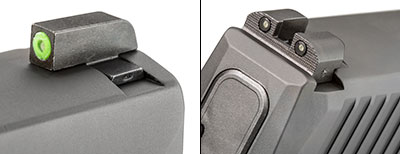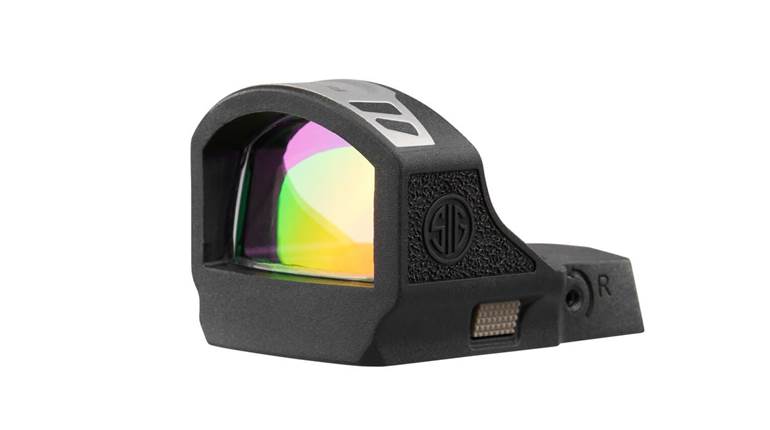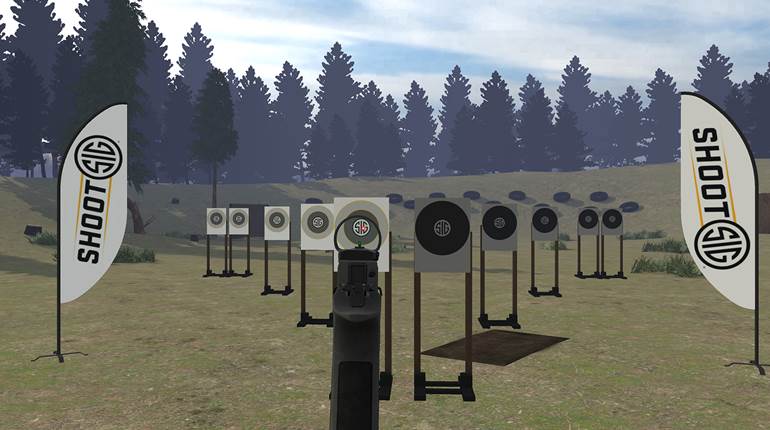

"It’s all about the magazine. We started with the magazine, and then designed everything around that,” remarked SIG Sauer President and CEO Ron Cohen of the company’s new P365—a striker-fired, semi-automatic pistol chambered for 9 mm Luger and intended for everyday concealed carry. I caught up with Cohen during SIG’s range event in advance of the 2018 SHOT Show in Las Vegas, which was my first opportunity to put hands on the gun and put rounds downrange. Attendance at the event was limited to premier media representatives, and the buzz among my peers was wonderment at how the company had managed to pack more capacity—10 rounds of 9 mm Luger in the standard, flush-fit magazine—into a micro-compact firearm that is dimensionally similar to Smith & Wesson’s Shield, Springfield Armory’s XD-S, Ruger’s LC9s and the Glock 43. Each of those, for reference, holds seven 9 mm cartridges in their standard magazines, save the Glock, which carries six.
Cohen was quickly echoed by SIG’s Pistol Product Manager Phil Strader, “We actually developed a magazine from the ground up. This is our magazine, our magazine design. It’s patent-pending, and we found a way we can get 10 rounds in this tiny, little, short mag.” Prior to holding the gun, I expected to encounter a pistol that was slightly larger and wider than the aforementioned competitive models. What I found, instead, was a gun that, if anything, was smaller and lighter than others in the field. Strader continued, “We were able to keep the same width, 1" width, a much smaller-contour grip, and actually keep the size of the gun on par, actually below, the industry average. We took four major competitive guns … averaged their heights, their weights, their lengths and we’re shorter, lighter and thinner than almost every gun in the market.”
In the spirit of “trust but verify,” I had a P365 sent to the office posthaste, and like any championship contender, the gun wasn’t going to make it into the ring without first submitting to a thorough weigh-in. At 18.6 ozs., with an empty magazine, it is definitely among the lightest guns in the category. Too, in terms of width it is on par with the competition, though, like the competition, the gun is actually closer to 0.9" across the slide, and just a few hundredths over 1" at the controls. The P365 offers the same 3.1" barrel as the Shield and the LC9s, and it’s shorter than the G43 (3.4") and XD-S (3.3"), though I think the difference is ballistically negligible. Overall length and height for the P365 are 5.8" and 4.3" (with the flush-fit 10-round magazine), respectively, meaning the gun will, indeed, fit inside a smaller box than its competitors. However, the most noticeable difference, in my opinion, is how narrow the grip frame is. The circumference measures just 4.9" at its narrowest and right around 5" at the widest portion—both noticeably smaller, visually and tactically, than the micro-compact I’m best acquainted with, the Shield, at about 5.3" around.
How, then, did SIG pack more ammunition into a gun that is as small or smaller, in every dimension, than its direct competitors? “Pixie dust,” quipped Strader.

Semi-Double-Stack
Without doubt, SIG Sauer designed a micro-compact worthy of the name, but the hook, of course, is that despite its slim, trim and featherweight dimensions, the P365 gives up nothing in terms of magazine capacity—indeed, it outmatches its peers by a relatively wide margin. So how did SIG designers do it? At the most basic level, the P365 makes use of a double-stack magazine in a category populated by single-stacks—though, in both cases, such simplistic designations are not totally accurate. Take, for example, Smith & Wesson’s M&P Shield, now a stalwart in the micro-compact category, and perhaps the most popular 9 mm rendering to date. Despite its magazine often being classified as a single-stack or single-column design, the cartridges within are not actually vertically aligned, as in, say, an M1911 magazine. Instead, it is a semi-staggered stack, and the slight left- and right-offset frees up just enough real estate to accommodate seven cartridges, where a straight vertical stack might only have fit six. The trade-off is a magazine that is slightly wider than a single-stack, but since the parent gun still comes in at around 1" wide—the “standard” for the micro-compact category—it’s hardly an issue.

The P365 goes to the opposite end of the spectrum, in that it is very close to being a true double-column arrangement. Here again, though, we see a slight adjustment to the design, in this case a tighter, more vertical staggering than in standard double-stacks. To compare, the double-column magazine of SIG’s larger P320 is 0.86" wide, which allows two 9 mm Luger cartridges to very nearly sit side-by-side. The P365’s magazine is narrower at 0.81" wide, causing the cartridges to stack in a more staggered formation. Also, the uppermost portion of the P365 magazine—about 1" below the feed lips—is more aggressively “funneled” than the P320 magazine, ensuring the top two cartridges form a single, vertical stack for reliable feeding. Each P365 will ship with two 10-round units, one flush-fitting and one with a small, 0.45" grip extension. Even more interesting is the 12-round magazine, sold separately, that increases the grip height by 0.65" and effectively gives the gun twice the capacity of its competitors, putting it “danger close” to competing with larger, double-stack compacts. The innovative hybrid design—Strader referred to it as “semi-double-stack”—accomplished two major priorities for SIG Sauer’s design team: it facilitated an overall width very close to the 1" mark, and it measurably increases the capacity over current competitive models.

Beyond The Mag
It’s no secret that the American commercial firearm industry is still getting used to the new, post-Obama normal. One area that continues to be a bright spot is the market for small, personal-defense semi-automatics, and the P365 is, no doubt, SIG’s best attempt to capture a share. However, it was not that long ago that a new Shield could be purchased for just $250, after rebates, so SIG’s engineers were going to have to really deliver a feature-filled firearm that would also be efficient to manufacture. Significantly upping the onboard ammunition was a good start, but with a suggested retail price of $600 (likely closer to $500 at the gun shop counter) the P365 would still have to offer shooters some compelling characteristics to justify the investment. In the features department, it delivers.

Starting from the top, the P365 has a very good set of sights. SIG’s X-Ray3 Day/Night Sights feature a bright, fluorescent green front dot with a central tritium vial, paired with a black, horizontally serrated square-notch rear, also equipped with tritium inserts. The result is a fast, single-dot arrangement in bright conditions, and a glowing three-dot sight picture in low light. The X-Ray3 sights have been used before on SIG Sauer’s Legion series of pistols and other upgraded models such as the P320 X-Carry. They are very good sights, very easy to use, and, considering similar aftermarket sights cost $100 or more, they add real value to the P365.
The slide, though slim, features bilateral cocking serrations fore and aft. Forward cocking serrations are becoming more common on personal-defense and competition-style pistols because they facilitate “press-checking” the firearm—that is, double-checking the gun’s condition, loaded or unloaded, by partially retracting the slide to visually observe the chamber. This is usually done by gripping the gun near the front of the slide to ensure the support hand does not block the view of the chamber. A rectangular window at the rear of the P365’s barrel assembly serves as a visual loaded-chamber indicator, rendering the press-check unnecessary, but the forward cocking serrations still make good sense because the gun and slide are so small. Large-handed shooters, or anyone trying to manipulate the slide under duress, may experience incidental contact with the forward serrations, and the angled cuts will provide improved purchase.

Moving on to the polymer frame, the left side of the P365 features three familiar controls: takedown lever, slide lock/release and magazine release. The takedown lever is directly above the trigger with the slide lock just to the rear, and the triangular magazine release is in its usual position at the bottom, rear junction of the trigger guard and frame. The magazine-release button is actually reversible for use by lefties, and it’s smooth engagement surface contours down and in, toward the trigger guard, following the natural lines of the frame. The arrangement is quite stylish and certainly helps maintain the P365’s slim dimensions. In fact, all aspects of the frame are cut and contoured to improve ergonomics and utility, and to minimize width. Bilateral recesses behind the trigger provide the strong-hand digits an easy approach to the trigger and a natural thumb rest; the frame is undercut beneath the trigger guard and paired with a relatively deep beavertail to facilitate a high grip; four textured panels (front, rear and both sides) improve purchase with gritty, but not aggressive, molded stippling; and the magazine well features bilateral cutouts to aid magazine removal. There is even an integral accessory rail for the addition of a light or laser sight, however, I expect opinions to be split on this feature since, rather than using a standard Picatinny-style rail, the P365 sports a proprietary arrangement of bilateral V-shaped grooves designed to allow accessories from SIG’s electro-optics division to be clamped on. I suppose such design decisions are a privilege enjoyed by “the complete systems provider.”
On The Range
As I stated at the top, my first opportunity to shoot the P365 was at SIG Sauer’s pre-SHOT Show media event in January. At the time, I was among the agog, eager to see the little SIG with the big magazine. On the line, shooting the P365 was a treat. The sample gun ran like a champ for not just me but dozens of shooters. Recoil was a bit snappy, but that was to be expected from such a small, lightweight pistol. Overall, the gun looked great, felt great and shot great. I couldn’t wait to get one back on the NRA test range, and before I had even returned from Las Vegas, a P365 had arrived at the office for evaluation. As soon as I was able, I was on the range and ready to ride the wave of excitement that the gun had generated at SHOT.
The first P365 I received was topped with SIGLite Night Sights—as was universally advertised at the gun’s launch—which are fine tritium-powered sights that top many SIG pistols. Unfortunately, even my brief range session had managed to kill the tritium vial in the front sight, dead. You see, the slide on a small 9 mm pistol reciprocates much faster and with more force than a larger, heavier gun, so while the SIGLites had proven their mettle with military and law enforcement agencies—taking down trash the world over—the recoil of the diminutive P365, a gun designed for civilian carry and personal defense, proved too much for the steel-clad sights.
Calls to SIG revealed that we had received the wrong gun. It was actually a pre-production model that should never have been released from the factory. A new gun arrived, built to spec and sporting new, and more robust, X-Ray3 Day/Night Sights—seems SIG engineers found the same weakness I had, and quietly corrected it.
What follows is a performance evaluation of the P365 using a sample gun pulled straight off the production line. With a production sample P365 in hand, I went straight to work at the range, and was immediately relieved when it fed, fired and ejected five magazines worth of mixed 9 mm Luger cartridges—ranging in weight from 65 grs. to 147 grs.—without issue. Velocity testing of three selected loads continued without incident, and accuracy testing was extremely satisfying (full results on p. 51). For a pistol with less than 5" of sight radius, the P365 continually shot ragged-hole five-shot groups at 7 yds., and was easy to keep “in the black” at 15 and 25 yds. The X-Ray3 sights are easy for the eyes to acquire, from the draw and after recoil, and are sighted to a combat or center hold—the part of the target that is covered by the front sight is exactly where the bullets impact.

I will warn readers, though, that the P365 does have some idiosyncrasies. This is a small gun, and there is very little real estate to hang on to. I typically use a high, aggressive, thumbs-forward grip when I shoot, and there just was not room to accommodate that style of grip. Early on, in fact, the meat of my support hand accidentally engaged the left-side controls and caused a couple of problems before I corrected my grip. As with any gun of this type, it doesn’t take much to engage the slide lock/release during a multi-shot string, and the most common side effect is a failure of the gun to lock open on an empty magazine. The P365’s slide lock can also be pressed upward, causing additional friction as the slide reciprocates and, in the worst case, can prevent the slide from returning fully to battery, resulting in failures to fire and identifiable by light primer strikes. The bottom line, in my opinion, is that the P365 definitely requires training and practice to perfect its use. Good, steady, two-handed grips are possible to achieve, and I was able to run the gun with 100 percent reliability, but it required an adjustment of my preferred hand position. For those who intend to carry the P365, or any micro-compact, make sure you are comfortable and confident with its characteristics and manual of arms.
With formal testing completed, and being more familiar with the handling qualities of the gun, I was able to spend some time just shooting. I did informal strings of fire, timed drills, precise shots from various distances and some work from the holster using a BlackPoint Tactical AIWB rig furnished by SIG. Throughout, the gun performed admirably. And how about that 12-round magazine? The larger grip is a revelation when it comes to controlling the gun and making fast follow-on shots—a trait especially apparent as I performed two high-speed, six-shot Bill Drills. Did I mention that I didn’t have to reload in between? It’s hard not to be impressed by the gun’s capacity. Sure, it’s a bit snappy with heavier loads, and it requires a little practice to shoot quickly, but for such a little gun to hold so much ammunition and still “disappear” into a concealment holster beneath a loose T-shirt, it really challenges the perception that concealment requires compromise.







































